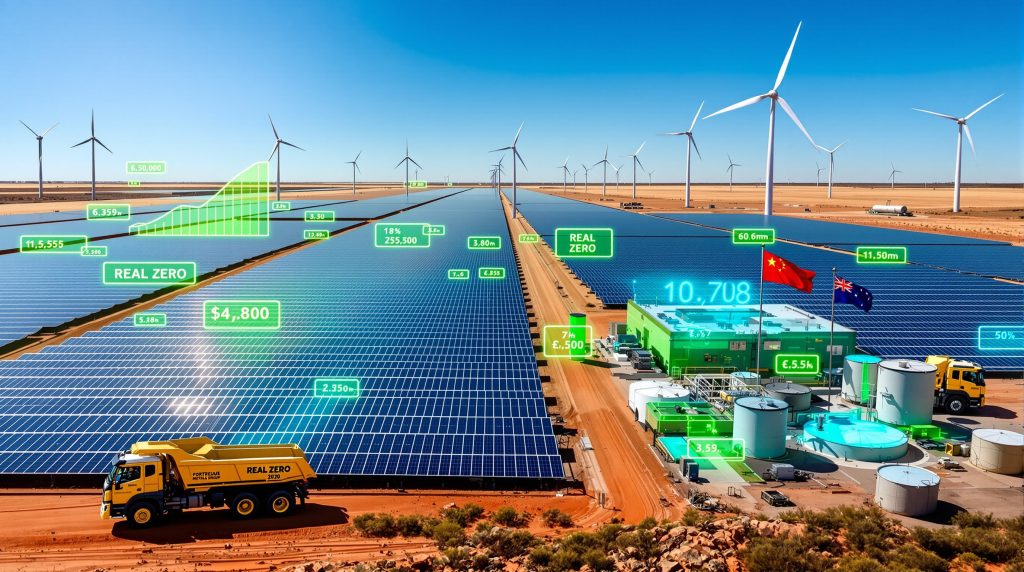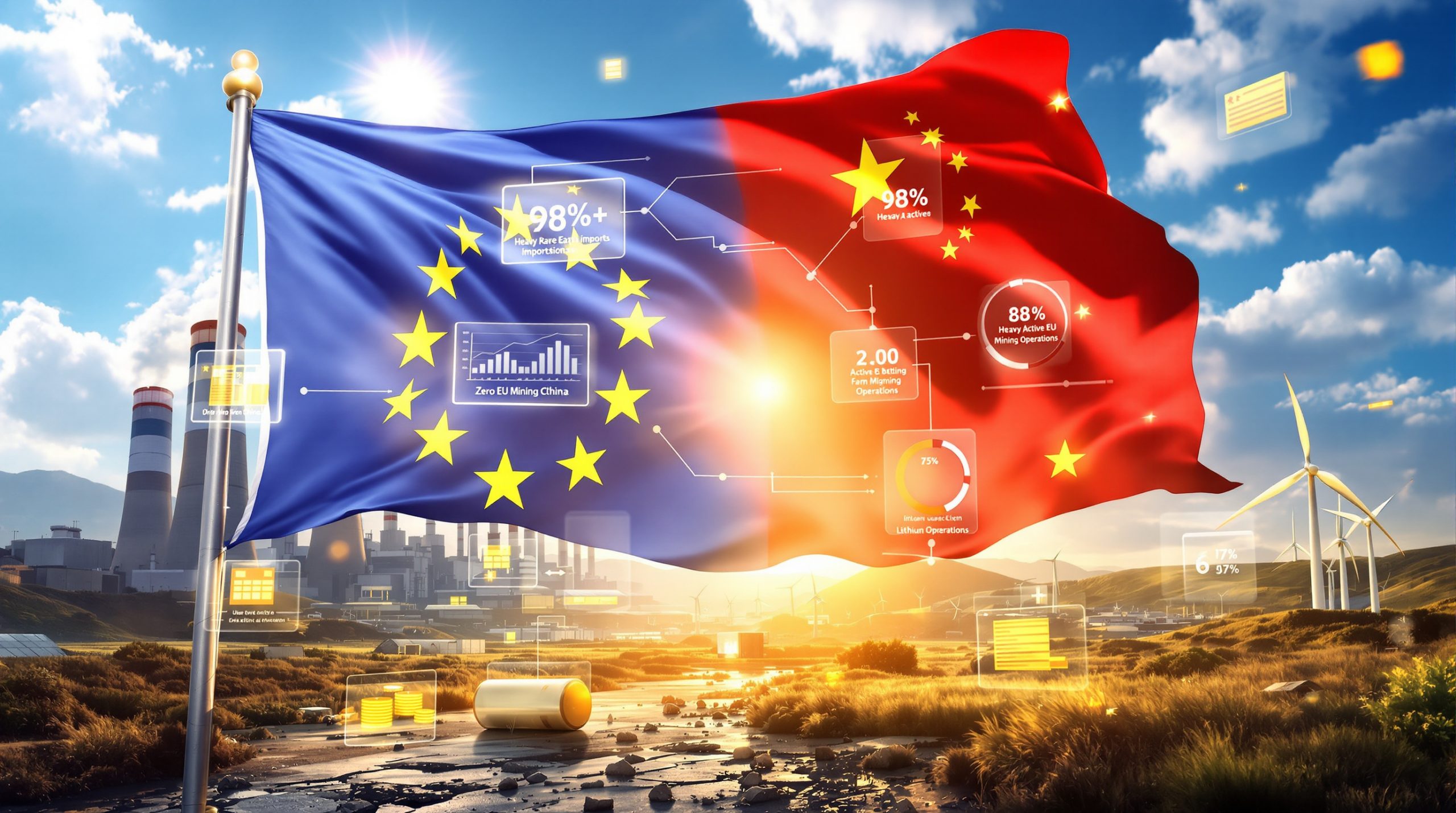Fortescue's Global Green Energy Partnerships: Accelerating the Path to Zero Emissions
Fortescue Metals Group is pioneering a transformative approach to decarbonisation through strategic global partnerships. While many mining companies discuss sustainability goals, Fortescue has committed to eliminating fossil fuel use across its operations by 2030 through its "Real Zero" initiative—a bold strategy that rejects carbon offsets in favor of genuine emissions elimination.
The company's shares recently showed resilience amid broader market declines, supported by strong iron ore prices and growing investor confidence in its green energy transition strategy. This market performance reflects increasing recognition of Fortescue's leadership in sustainable mining practices.
What Strategic Partnerships Is Fortescue Forming to Achieve Decarbonisation?
Global Technology Alliances
Fortescue has established partnerships with four international green technology leaders, each bringing specialized expertise to different aspects of the decarbonisation challenge:
-
BYD: Collaboration focuses on electric vehicle technology and battery storage systems to electrify mining operations
-
LONGi: Partnership leverages advanced solar technology to power Fortescue's Pilbara operations with renewable energy
-
XCMG: Agreement centers on developing and deploying battery-electric mining equipment, including heavy-duty vehicles
-
Envision Energy: Cooperation targets wind power generation and energy storage solutions to create reliable renewable power systems
These partnerships build upon Fortescue's existing relationship with European equipment manufacturer Liebherr, which is already producing T 264 trucks designed to incorporate battery-electric power systems at its Virginia facility in the United States.
Nabrawind Acquisition
Fortescue has finalized its acquisition of Spanish renewable technology company Nabrawind, strengthening its capabilities in wind energy innovation. This strategic move adds European engineering expertise to Fortescue's growing portfolio of renewable energy technologies.
Why Is Global Collaboration Central to Fortescue's Decarbonisation Strategy?
Leveraging International Innovation Ecosystems
Fortescue's approach recognizes that no single company or country has all the solutions needed for industrial-scale decarbonisation. By creating a global network of partners, the company gains access to:
-
China's manufacturing scale and rapid deployment capabilities
-
European engineering excellence and renewable energy innovation
-
American industrial production capacity and technological development
-
Australian operational expertise and testing environments
This multilateral strategy enables Fortescue to combine diverse technological approaches and accelerate implementation timelines that would be impossible working in isolation.
Creating a Global R&D Network
Executive Chairman Andrew Forrest highlighted the strategic importance of this international approach, stating: "This is a truly multilateral collaboration that draws on the best ideas and manufacturing capacity to deliver the lowest cost energy and tackle climate change."
The company is establishing interconnected innovation hubs across multiple continents:
- Fortescue Zero in the United Kingdom
- Nabrawind in Spain
- Liebherr facilities in Germany and the United States
- Manufacturing partnerships in China
- Operational testing in Western Australia's Pilbara region
What Makes Fortescue's "Real Zero by 2030" Target Distinctive?
Beyond Net-Zero Commitments
While many mining companies have announced "net-zero" targets that rely heavily on carbon offsets, Fortescue's "Real Zero" approach represents a fundamental shift in strategy:
| Traditional "Net-Zero" Approach | Fortescue's "Real Zero" Approach |
|---|---|
| Continues using fossil fuels | Eliminates fossil fuel use entirely |
| Purchases carbon credits to offset emissions | Generates no emissions requiring offsets |
| Often targets 2040-2050 timeframes | Aims for complete decarbonisation by 2030 |
| Focuses primarily on Scope 1 & 2 emissions | Addresses entire operational footprint |
Comprehensive Operational Transformation
Fortescue's strategy involves transforming every aspect of its mining operations:
-
Fleet Electrification: Converting all mining vehicles to battery-electric power
-
Renewable Energy Generation: Developing solar, wind, and battery storage to power operations
-
Green Hydrogen Production: Creating zero-emission fuel for processes requiring high energy density
-
Supply Chain Decarbonisation: Extending emissions reduction efforts to transportation and logistics
How Will These Partnerships Impact Fortescue's Business Model?
Dual-Track Strategy: Mining and Green Technology
Fortescue is positioning itself not just as a mining company but as an integrated green energy and resources business. This evolution creates:
-
Diversified Revenue Streams: Potential to commercialize technologies developed through these partnerships
-
Competitive Advantage: Lower operational costs through reduced fuel expenses and energy independence
-
Market Differentiation: Ability to offer lower-carbon iron ore products to environmentally conscious customers
-
Regulatory Resilience: Reduced exposure to future carbon pricing and emissions regulations
Financial Implications
Investors appear to be responding positively to Fortescue's strategy, with shares showing resilience despite broader market volatility. The company's stock has gained approximately 2% in 2025, excluding the recently paid 60 cents per share fully franked dividend.
What Challenges Must Fortescue Overcome to Achieve Its Decarbonisation Goals?
Technological Hurdles
Several significant challenges remain in implementing zero-emission mining at scale:
-
Battery Technology Limitations: Current battery recycling innovation and technology still struggles with the extreme power requirements of heavy mining equipment
-
Renewable Energy Reliability: Ensuring consistent power supply in remote mining locations
-
Green Hydrogen Economics: Reducing production costs to make hydrogen economically viable as a fuel alternative
-
Integration Complexity: Coordinating multiple new technologies across diverse operational environments
Implementation Timeline Pressure
With 2030 as the target date, Fortescue faces significant pressure to:
- Scale new technologies rapidly
- Train workforce on new systems and processes
- Maintain production levels during transition
- Manage capital expenditure requirements
How Does Fortescue's Approach Compare to Industry Peers?
Leading the Mining Sector
Fortescue's aggressive timeline and comprehensive approach distinguish it from other major mining industry innovation leaders:
| Company | Emissions Target | Target Date | Reliance on Offsets |
|---|---|---|---|
| Fortescue | Real Zero (complete elimination) | 2030 | None |
| BHP | Net Zero | 2050 | Partial |
| Rio Tinto | Net Zero | 2050 | Partial |
| Vale | Net Zero | 2050 | Significant |
Setting New Industry Standards
By demonstrating the technical and economic feasibility of zero-emission mining, Fortescue could accelerate industry-wide adoption of similar practices, potentially transforming expectations for the entire resources sector.
What Are the Broader Implications of Fortescue's Decarbonisation Partnerships?
Global Technology Transfer
These partnerships facilitate knowledge exchange between regions with different technological strengths:
- China's manufacturing scale and battery technology
- European renewable energy innovation
- Australian operational expertise in harsh environments
This cross-pollination of ideas and capabilities could accelerate global sustainability transformation efforts beyond the mining sector.
Supply Chain Transformation
As a major iron ore producer, Fortescue's decarbonisation efforts have significant implications for the steel industry's carbon footprint. By developing zero-emission mining practices, the company is addressing an important component of steel's overall environmental impact, further supporting Australia's green metals leadership.
FAQ: Fortescue's Decarbonisation Strategy
How will Fortescue power its heavy mining equipment without diesel?
Fortescue plans to deploy battery-electric vehicles for most applications, with green hydrogen potentially serving as fuel for equipment with the most demanding power requirements.
What economic benefits might Fortescue realize from its decarbonisation efforts?
Beyond potential cost savings from eliminated fuel purchases, Fortescue could benefit from premium pricing for lower-carbon iron ore products, reduced regulatory risks, and potential commercialization of technologies developed through these partnerships.
How is Fortescue financing its decarbonisation initiatives?
The company is leveraging its strong cash flow from iron ore operations to fund the transition, while also exploring green financing options and potential government support for renewable energy projects.
Will Fortescue's decarbonisation efforts affect its iron ore production capacity?
The company has emphasized that the transition must maintain or enhance productivity, with new technologies being designed to match or exceed the performance of conventional equipment.
Further Exploration:
Readers interested in learning more about sustainable mining practices and energy transition insights can also explore related educational content, such as The Motley Fool Australia's article on Fortescue's decarbonisation news, which offers another perspective on the company's renewable energy initiatives. Additionally, you can find more detailed information directly from Fortescue's official recognition as a global leader in decarbonisation.
Interested in Identifying the Next Major Mining Innovation or Discovery?
Discovery Alert's proprietary Discovery IQ model provides real-time notifications when significant mineral discoveries are announced on the ASX, giving you the market edge to capitalise on potential opportunities before they become mainstream news. Explore historical returns from major discoveries at the Discovery Alert discoveries page and position yourself ahead of the market.




